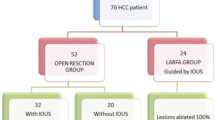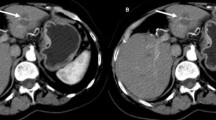Abstract
Purpose
The purpose of this paper is to compare intraoperative biopsy results of previously ablated liver tumors with their preoperative computed tomography (CT) and intraoperative laparoscopic ultrasound (LUS) appearances in patients undergoing repeat radiofrequency ablation (RFA).
Methods
Seventy repeat RFA procedures were performed in 59 (13%) patients. Laparoscopically, suspected recurrent and stable appearing foci were biopsied using an 18 G biopsy gun. Preoperative CT and LUS appearances of the previously ablated lesions were compared with core biopsy results.
Results
There were 33 patients with colorectal cancer, 11 with hepatocellular cancer, 8 with neuroendocrine tumors, and 7 with other tumor types. Two hundred lesions were treated by RFA in these 70 repeat ablations. Suspected recurrent tumor foci were enhanced on CT and produced a more finely stippled echo pattern on LUS. Biopsy confirmed recurrent tumor in 72 of 84 such lesions. Previously ablated foci had a CT appearance of a hypodense, nonenhancing lesion without evidence of adjacent enhancing foci. Laparoscopic ultrasound appearance was of a hypoechoic lesion with a coarse internal pattern with the tracks of the ablation catheter probes often still visible. Biopsy found necrotic tissue in 21 of 22 such lesions appearing radiologically to be without recurrence. Biopsy of an ablated focus adjacent to an area of suspected recurrence showed necrotic tissue in 17 of 22 lesions and viable cancer in 5.
Conclusion
CT and LUS appearance of previously ablated foci showed good correlation with core biopsies. CT scan is reliable in following RFA lesions, without the need for routine biopsy. LUS reliably distinguished recurrent from ablated lesions in patients undergoing repeat ablation.



Similar content being viewed by others
References
Bengmark S, Hafstrom L. The natural history of primary and secondary malignant tumors of the liver. I. The prognosis for patients with hepatic metastases from colonic and rectal carcinoma by laparotomy. Cancer 1969;23(1):198–202.
Silverberg E, Boring CC, Squires TS. Cancer statistics, 1990 [see comments]. CA Cancer J Clin 1990;40(1):9–26.
Okuda K, Obata H, Nakajima Y, Ohtsuki T, Okazaki N, Ohnishi K. Prognosis of primary hepatocellular carcinoma. Hepatology 1984;4(1 Suppl):3S–6S.
Akerstrom G. Management of carcinoid tumors of the stomach, duodenum, and pancreas. World J Surg 1996;20(2):173–182.
di Bartolomeo M, Bajetta E, Buzzoni R, Mariani L, Carnaghi C, Somma L, Zilembo N, di Leo A. Clinical efficacy of octreotide in the treatment of metastatic neuroendocrine tumors. A study by the Italian Trials in Medical Oncology Group. Cancer 1996;77(2):402–408.
Faiss S, Scherubl H, Riecken EO, Wiedenmann B. Drug therapy in metastatic neuroendocrine tumors of the gastroenteropancreatic system. Recent Results Cancer Res 1996;142:193–207.
Steele G Jr, Ravikumar TS, Benotti PN. New surgical treatments for recurrent colorectal cancer. Cancer 1990;65(3 Suppl):723–730.
Stangl R, Altendorf-Hofmann A, Charnley RM, Scheele J. Factors influencing the natural history of colorectal liver metastases. Lancet 1994;343(8910):1405–1410.
Farmer DG, Rosove MH, Shaked A, Busuttil RW. Current treatment modalities for hepatocellular carcinoma. Ann Surg 1994;219(3):236–247.
McEntee GP, Nagorney DM, Kvols LK, Moertel CG, Grant CS. Cytoreductive hepatic surgery for neuroendocrine tumors. Surgery 1990;108(6):1091–1096.
Ravikumar TS. Interstitial therapies for liver tumors. Surg Oncol Clin N Am 1996;5(2):365–377.
McGahan J, Schneider P, Brock J. Treatment of liver tumors by percutaneous RF electrocautery. Semin Intervent Radiol 1993;10(2):143–149.
Rossi S, Fornari F, Buscarini L. Percutaneous ultrasound guided radiofrequency electrocautery for the treatment of small hepatocellular carcinoma. J Interv Radiol 1993;8:97–103.
Rossi S, Di Stasi M, Buscarini E, Cavanna L, Quaretti P, Squassante E, Garbagnati F, Buscarini L. Percutaneous radiofrequency interstitial thermal ablation in the treatment of small hepatocellular carcinoma. Cancer J Sci Am 1995;1(1):73.
Berber E, Ari E, Herceg N, Siperstein A. Laparoscopic radiofrequency ablation for unusual hepatic tumors: operative indications and outcome. Surg Endosc 2005;19:1613–1617.
Berber E, Pelley R, Siperstein AE. Predictors of survival after radiofrequency thermal ablation of colorectal cancer metastases to the liver: a prospective study. J Clin Oncol 2005;23(7):1358–1364.
Berber E, Flesher NL, Siperstein AE. Laparoscopic radiofrequency ablation of neuroendocrine liver metastases. World J Surg 2002;26(8):985–990.
Siperstein A, Garland A, Engle K, Rogers S, Berber E, Foroutani A, String A, Ryan T, Ituarte P. Local recurrence after laparoscopic radiofrequency thermal ablation of hepatic tumors. Ann Surg Oncol 2000;7(2):106–113.
Berber E, Foroutani A, Garland AM, Rogers SJ, Engle KL, Ryan TL, Siperstein AE. Use of CT Hounsfield unit density to identify ablated tumor after laparoscopic radiofrequency ablation of hepatic tumors. Surg Endosc 2000;14(9):799–804.
Siperstein A, Garland A, Engle K, Rogers S, Berber E, String A, Foroutani A, Ryan T. Laparoscopic radiofrequency ablation of primary and metastatic liver tumors. Technical considerations. Surg Endosc 2000;14(4):400–405.
Berber E, Flesher NL, Siperstein AE. Initial clinical evaluation of the RITA 5-centimeter radiofrequency thermal ablation catheter in the treatment of liver tumors. Cancer J Sci Am 2000;6(S4):S319–S329.
Berber E, Herceg NL, Casto KJ, Siperstein AE. Laparoscopic radiofrequency ablation of hepatic tumors: Prospective clinical evaluation of ablation size comparing two treatment algorithms. Surg Endosc 2004;18(3):390–396.
Ebara M, Kita K, Sugiura N, Yoshikawa M, Fukuda H, Ohto M, Kondo F, Kondo Y. Therapeutic effect of percutaneous ethanol injection on small hepatocellular carcinoma: evaluation with CT. Radiology 1995;195(2):371–377.
McLoughlin RF, Saliken JF, McKinnon G, Wiseman D, Temple W. CT of the liver after cryotherapy of hepatic metastases: imaging findings. AJR Am J Roentgenol 1995;165(2):329–332.
Curley SA, Izzo F, Delrio P, Ellis LM, Granchi J, Vallone P, Fiore F, Pignata S, Daniele B, Cremona F. Radiofrequency ablation of unresectable primary and metastatic hepatic malignancies: results in 123 patients [see comments]. Ann Surg 1999;230(1):1–8.
Solbiati L, Livraghi T, Goldberg SN, Ierace T, Meloni F, Dellanoce M, Cova L, Halpern EF, Gazelle GS. Percutaneous radio-frequency ablation of hepatic metastases from colorectal cancer: long-term results in 117 patients. Radiology 2001;221:159–166.
Ahmad A, Chen SL, Kavanagh MA, Allegra AP, Bickel A. Radiofrequency ablation of hepatic metastases from colorectal cancer: are newer generation probes better? Am Surg 2006;72:875–879.
Abdalla EK, Vauthey JN, Ellis LM, Ellis V, Pollock R, Broglio KR, Hess K, Curley SA. Recurrence and outcomes following hepatic resection, radiofrequency ablation, and combined resection/ablation for colorectal liver metastases. Ann Surg 2004;239(6):818–825; discussion 825–827.
Dromain C, De Baere T, Elias D, Kuoch V, Ducreux M, Boige V, Petrow P, Roche A, Sigal R. Hepatic tumors treated with percutaneous radio-frequency ablation: CT and MR Imaging follow up. Radiology 2002;223:255–262.
Author information
Authors and Affiliations
Corresponding author
Rights and permissions
About this article
Cite this article
Mason, T., Berber, E., Graybill, J.C. et al. Histological, CT, and Intraoperative Ultrasound Appearance of Hepatic Tumors Previously Treated by Laparoscopic Radiofrequency Ablation. J Gastrointest Surg 11, 1333–1338 (2007). https://doi.org/10.1007/s11605-007-0214-z
Received:
Accepted:
Published:
Issue Date:
DOI: https://doi.org/10.1007/s11605-007-0214-z




